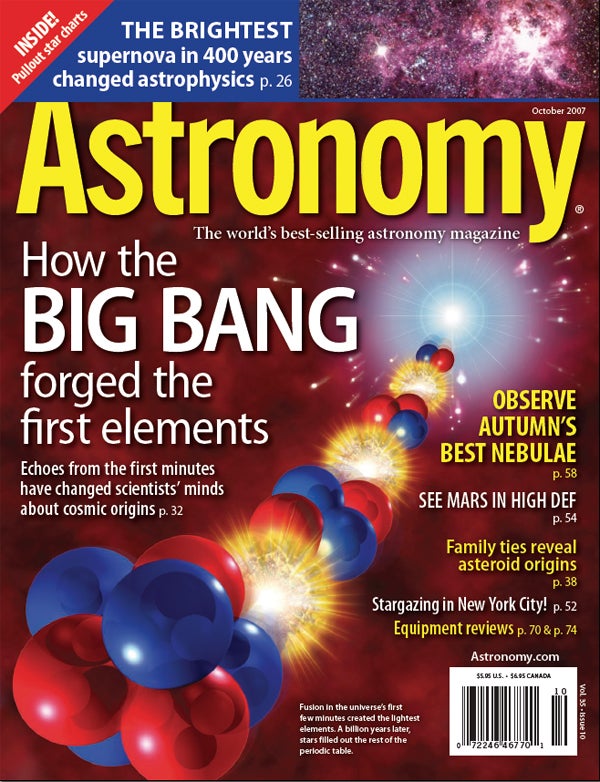
September 11, 2007
WAUKESHA, WI – Today, observers see galaxies rushing away from each other in our expanding universe. But if you run cosmic evolution backward, everything draws together. The cosmos become denser, galaxies melt into primordial gas, which eventually breaks down into a sea of protons and neutrons.
Nuclear reactions between protons and neutrons in the universe’s first 3 minutes made the lightest elements. This find changed scientists’ minds about cosmic origins. In “How the Big Bang forged the first elements,” astrophysicist Adam Frank explains how Big Bang nucleosynthesis is spinning out a detailed picture of our cosmic beginnings.
“Big Bang nucleosynthesis shows us that a brief period of well-understood physics has consequences that trickle down 13.7 billion years to the universe we observe,” Frank writes.
Astronomy‘s October issue moves forward in time from the Big Bang to 1987 in “Supernova 1987A: 20 years later.” Astronomy Senior Editor Richard Talcott takes readers on a trip to February 23, 1987, when astronomers discovered the brightest supernova in nearly 400 years. The supernova taught astronomers a great deal about exploding stars – and points out a lot they still don’t know.
The October issue of Astronomy is available now on newsstands everywhere.
More resources from Astronomy.com:
- Astronomy news
This week’s sky events
Astronomy basics
Glossary of astronomical terms
Return to Astronomy “For the media” page
Astronomy promotes the science and hobby of astronomy through high-quality publications that engage, inform, entertain, and inspire. The October issue of Astronomy is available now on newsstands everywhere.
It’s all relative
When astronomers traced the history of 39 asteroids with closely-related orbits, they were surprised to discover the orbits converged as recently as 5.8 million years ago. The Karin cluster, probably created when a smaller asteroid slammed into a larger parent body, has since grown to 90 members. Planetary scientist Daniel Durda explains how the discovery was made in “Family ties reveal asteroid origins.”
The Moon and New York City
One night, sidewalk astronomer Jeffrey Jacobs offered passersby a free look at the Moon through a telescope. But would skeptical New Yorkers accept the gift? Phil Scott invites readers to “Come see the Moon!” in his story of street-corner astronomy in New York. “Where we live is not this small intersection in the Village,” writes Scott. “Where we really live is on a blue-and-white planet, orbited by a pitted gray moon, orbiting a yellow star, which orbits a spiral galaxy inside a vast universe.”
Deep-sky observing
Intricate gas clouds and sparkling stars await readers in the October issue. “Observe autumn’s best nebulae” teaches you how to spot photogenic, bright emission nebulae such as the Cepheus giants and the Bubble Nebula. With a little planning and a clear dark sky, some of the objects on author Richard Jakiel’s list may become your favorites, too.
Also in the October 2007 Astronomy:









